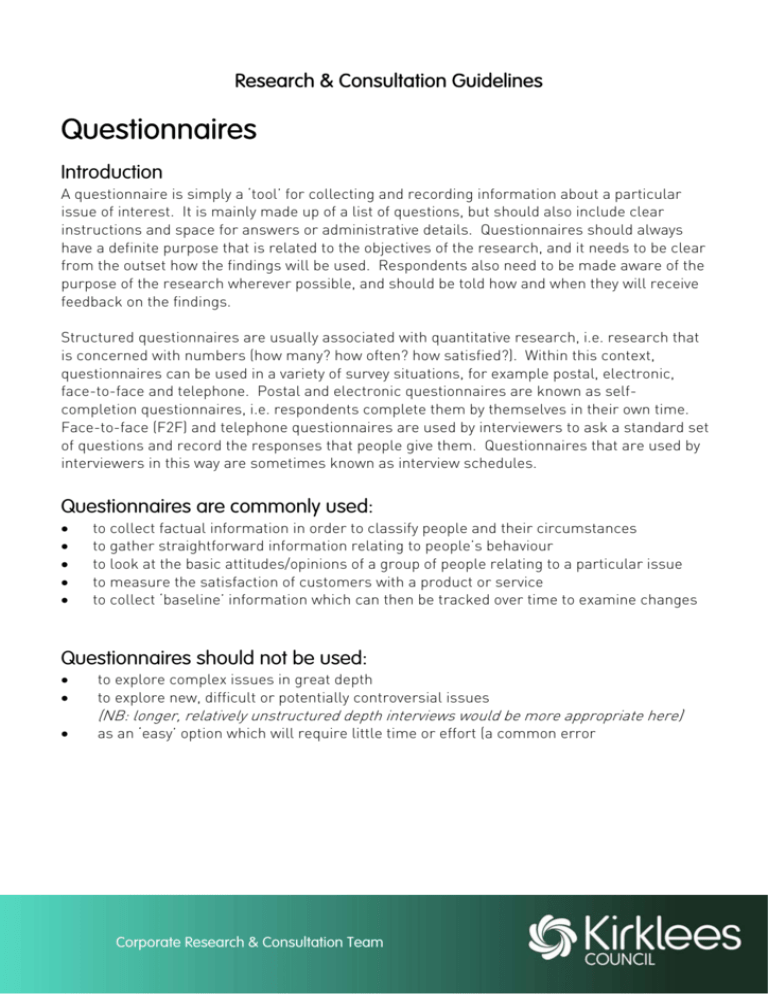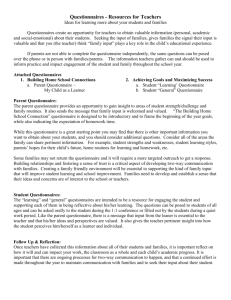Questionnaires
advertisement

Research & Consultation Guidelines Questionnaires Introduction A questionnaire is simply a ‘tool’ for collecting and recording information about a particular issue of interest. It is mainly made up of a list of questions, but should also include clear instructions and space for answers or administrative details. Questionnaires should always have a definite purpose that is related to the objectives of the research, and it needs to be clear from the outset how the findings will be used. Respondents also need to be made aware of the purpose of the research wherever possible, and should be told how and when they will receive feedback on the findings. Structured questionnaires are usually associated with quantitative research, i.e. research that is concerned with numbers (how many? how often? how satisfied?). Within this context, questionnaires can be used in a variety of survey situations, for example postal, electronic, face-to-face and telephone. Postal and electronic questionnaires are known as selfcompletion questionnaires, i.e. respondents complete them by themselves in their own time. Face-to-face (F2F) and telephone questionnaires are used by interviewers to ask a standard set of questions and record the responses that people give them. Questionnaires that are used by interviewers in this way are sometimes known as interview schedules. Questionnaires are commonly used: • • • • • to collect factual information in order to classify people and their circumstances to gather straightforward information relating to people’s behaviour to look at the basic attitudes/opinions of a group of people relating to a particular issue to measure the satisfaction of customers with a product or service to collect ‘baseline’ information which can then be tracked over time to examine changes Questionnaires should not be used: • • to explore complex issues in great depth to explore new, difficult or potentially controversial issues (NB: longer, relatively unstructured depth interviews would be more appropriate here) • as an ‘easy’ option which will require little time or effort (a common error Corporate Research & Consultation Team Advantages and disadvantages of using questionnaires • Advantages Can contact a large number of people at a relatively low cost (postal and telephone) • Disadvantages Response rates can be low (postal) and refusal rates high (telephone, F2F) • Easy to reach people who are spread • across a wide geographical area or who live in remote locations (postal and phone) There is little control over who completes a postal questionnaire, which can lead to bias • Respondents are able to complete postal questionnaires in their own time and telephone call-backs can be arranged for a more convenient time • Postal questionnaires are inappropriate for people with reading difficulties or visual impairments and those who do not read English • Telephone questionnaires can make it easier to consult some disabled people • Postal and phone questionnaires must be kept relatively short • F2F questionnaires can make it easier to identify the appropriate person to complete the questionnaire • F2F and phone questionnaires require the use of trained interviewers • F2F questionnaires can be longer than postal and phone questionnaires, collect more information and allow the use of ‘visual aids’ • F2F questionnaires are time consuming for respondents, more costly and more labour intensive than other methods -2- Questionnaire design In order to gather useful and relevant information it is essential that careful consideration is given to the design of your questionnaire. A well-designed questionnaire requires thought and effort, and needs to be planned and developed in a number of stages: Initial considerations Question content, phrasing and response format Question sequence and layout Pre-test (pilot) and revision Final questionnaire Initial considerations Firstly, it is important to be clear about the type and nature of information you need to collect and exactly who is your target population (e.g. North Kirklees residents). You also need to decide on the most appropriate method for administering the questionnaire (e.g. postal) and consider your approach to sampling. For further information on sampling techniques see the guideline on ‘Sampling’. Finally, it is useful to consider how the findings will be analysed as this may have an impact on the design of the questionnaire. More information on analysis can be found in the guideline on ‘Analysing and reporting quantitative data’. -3- Question content, phrasing and response format The second, and perhaps most important, aspect of questionnaire design relates to the questions themselves. You need to make sure that each question: • • • Adds value. If it is just ‘nice to know’ and does not add value, leave it out. Is clear and easy to understand. Asks what you think it is asking and does not cause confusion. Writing questions is a creative process and there is no standard format for a ‘good’ question. However, more information on questions and how to avoid some of the common mistakes is available in the guideline on ‘Writing Questions’. The use of standardised questions is also worth considering. The Office of National Statistics has developed ‘harmonised’ questions (e.g. ethnicity) to enable national comparisons of findings. Further information is available at http://www.statistics.gov.uk/harmony/. In addition, the Centre for Applied Social Surveys (CASS) Question Bank (http://qb.soc.surrey.ac.uk/) holds questionnaires for large scale social surveys that have been undertaken with nationally representative samples. Question sequence and layout Questions should be numbered and ordered in a way that is logical to the respondent, with similarly themed questions grouped together. A technique known as ‘funnelling’ begins with general questions before focusing down to more specific questions. Simple questions are often placed at the beginning to put respondents at ease. Some questions may require ‘routing’, (e.g. if ‘no’, go to Q4), but be careful not to make this too complex. It is also important to include clear instructions for the respondent or interviewer (e.g. ‘mark all that apply’). Equalities When designing your questionnaire you also need to remember to account for equalities issues. For example: • • • Questions on gender, age, ethnic origin and disability are sometimes used to monitor whether a representative cross-section of the population was reached (but it is bad practice to ask these questions and simply store the data rather than using it for a specific purpose). You may need to include a paragraph translated into minority ethnic languages for people who do not speak/read English as their first language. This should explain the focus of the survey and allow them to request a translated copy of the questionnaire. You may also need to include a statement in large print indicating that respondents can request a copy of the questionnaire transcribed into Braille or Large Text. More detailed information on consulting BME groups can be found in the guideline on ‘Research with black and minority ethnic groups’. -4- Confidentiality Respondents need to be reassured that the information they provide on the questionnaire is confidential. This means that their identities or personal details must not be disclosed to others, except for research purposes, and any data used in the report will not be linked to any respondents. If the questionnaire is not exclusively for research (for example, if it is used to update a database that is used for purposes other than research), then this should be made clear to respondents and the questionnaire cannot be described as confidential survey research. Piloting the questionnaire It is good practice to ‘pilot’ or pre-test your questionnaire with a small sample of respondents before use. The pilot should check people’s understanding and ability to answer the questions, highlight areas of confusion and look for any routing errors, as well as providing an estimate of the average time each questionnaire will take to complete. Any amendments highlighted by the pilot should be made to the questionnaire before issuing a final version. Maximising the response rate Questionnaires can suffer from low response rates, which are a source of bias. The following table outlines some of the steps that can be taken to help improve your survey response rate: Essential • Introductory letter • Reply paid envelope for returns Advisable • Reminder letter and second copy of the questionnaire after two weeks Negligible effect • Incentives • Coloured paper In addition to this, the length of the questionnaire, ease of completion and the relevance/interest of the subject matter to respondents are likely to affect the overall survey response rate. Further sources of information on questionnaires and questionnaire design • • • Market Research Society Questionnaire Design Guidelines http://www.mrs.org.uk/standards/downloads/revised/active/questionnaire_may06.pdf BMRA Researchers Toolkit 2003 http://www.bmra.org.uk/researchers-toolkit/index.asp (market research techniques – data collection methods – designing and conducting surveys). Oppenheim, A. N. (1992) Questionnaire design, interviewing and attitude measurement (2nd edition). London: St Martins Press. -5- What next? If you would like to know more about this topic or any other aspect of research or consultation, please contact any member of the team: Corporate Research and Consultation Team ℡ 01484 221748 (internal 860-1748) consultation@kirklees.gov.uk -6-





